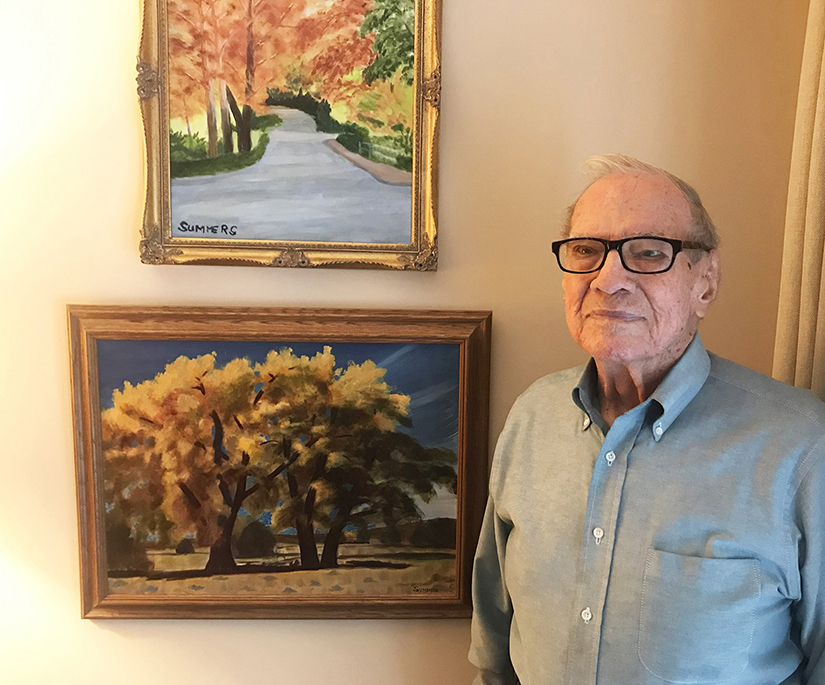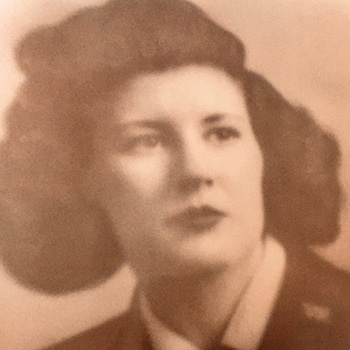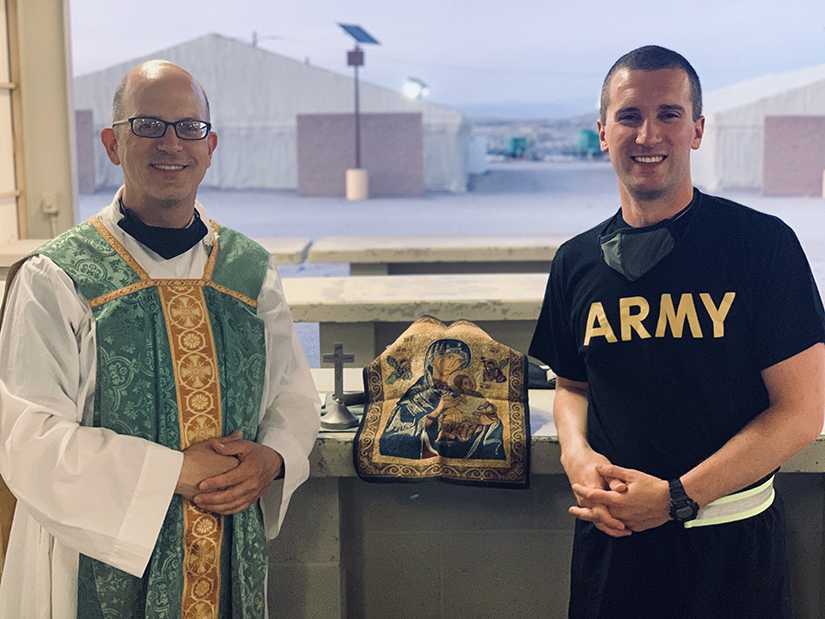‘Lucky all my life’
NASHVILLE — James Cornelius “Connie” Summers, a Naval aviator and a 1939 graduate of Father Ryan High School in Nashville, was on the
 James Cornelius “Connie” Summers, Navy aviatorPhoto Credits: Courtesy Connie Summers
James Cornelius “Connie” Summers, Navy aviatorPhoto Credits: Courtesy Connie SummersSouth Pacific island of Saipan when the war ended, preparing for the planned invasion of Japan.
“We were happy as can be,” Summers, 99, said of the reaction to the end of the war. The invasion of Japan “was going to be horrible,” he said. “They took no prisoners. If they captured you, you were dead.”
In April 1942, Summers, who was working for the telephone company when the war started, headed to the recruiting station to enlist, hoping to be assigned to a construction unit to take advantage of his work experience.
But a recruiter stopped him on his way in and asked if would consider becoming a Naval aviator. “I got my wings in June 1944, and shipped out for the Pacific Theater, assigned to the crew of PBM patrol bomber, a large seaplane with a crew of eight enlisted men and three officers, Summers said. “It was a big, big airplane.”
As one of the junior officers, Summers would alternate between serving as the co-pilot and the navigator. Based in Saipan, his crew flew missions bombing Japanese ships from Korea to Okinawa, with several close calls along the way.
At the end of one mission, Summers’ plane ran out of fuel and had to land on the open sea, “which is not fun,” he said. The plane landed near a convoy of five American ships, which were sunk by Japanese planes
After the war, Summers enrolled at Vanderbilt University on the GI Bill, but was still unsure what he wanted to do with the rest of his life. “I had no idea what I wanted to do,” Summers said. “I knew I didn’t want to fly airplanes.”
A professor suggested he consider law school, and with just enough money left for college, he enrolled in Vanderbilt Law School in 1947 and graduated in 1950. He went on to have a distinguished career as an attorney and public servant.
A parishioner at St. Henry Church, Summers served on the boards of Catholic Charities of Tennessee and St. Mary’s Child Development Center.
Summers summed up his experiences: “I’ve been lucky all my life.”
By Andy Telli, Catholic News Service
‘Semper Paratus — Always Ready’
 Shirley H. Reagor, U.S. Coast Guard Women’s ReservePhoto Credits: Courtesy Patricia Samse
Shirley H. Reagor, U.S. Coast Guard Women’s ReservePhoto Credits: Courtesy Patricia SamseHOUSTON — Seaman 1st Class Shirley H. Reagor once boarded an Italian submarine to perform her military duties as an enlisted member of the U.S. Coast Guard Women’s Reserve.
It was during World War II, and Americans had captured the submarine off Florida’s Atlantic Coast. Once Italian sailors were sent to a prisoner-of-war camp, Reagor’s job was to conduct an onboard inventory of the vessel.
She was among more than 11,000 women who served in the Women’s Coast Guard Reserves, known as SPARs, an acronym for “Semper Paratus — Always Ready.”
In November 1942, Congress allowed the Reserve to accept women as commissioned officers and at the enlisted level. Its purpose was to make more men available to serve at sea by assigning women to onshore duties during the war, primarily in clerical roles, according to Britannica.
“We performed traditional roles, mainly administrative and logistical functions that included communication and transmissions of orders, order processing, and supply inventory at shore stations,” Reagor, a Houston resident, told the Texas Catholic Herald, newspaper of the Archdiocese of Galveston-Houston.
Since those days, Reagor has been recognized for her achievements and military duty.
Recently, Reagor received the Living Legend Award from the Women in Military Service for America, an organization she wished received more funding and recognition.
For her 100th birthday, Reagor was thrilled when the U.S. Coast Guard Houston-Galveston Sector honored her with a boat drive-by, unit coins and a letter of appreciation from them and the admiral of the Coast Guard. Houston Mayor Sylvester Turner also declared her birthday “her day.”
Besides a daughter, Reagor has a son who is a priest: Father Scott Dugas, pastor of St. Joseph Catholic Church in Woodville, Mississippi, in the Jackson Diocese. He also works with local veterans’ organizations in a chaplain’s capacity.
Born in Franklin, North Carolina, and initially raised as a Southern Baptist, Reagor has always been deeply involved in the Catholic Church in some form or another. She joined the church at St. Cyril of Alexandria Church and was baptized by her son.
By Eleska Aubespin, Catholic News Service
A life of faith
NASHVILLE —After serving in Europe as part of the final push into Germany, John Burns and his twin brother, Bob, were at Camp Campbell, as it was called then, on the Tennessee-Kentucky state line training for the invasion of Japan when the war came to a close.
“It was a relief,” said Burns, a 1944 graduate of Father Ryan High. “Seeing what we saw, we were getting ready to go back into the same thing.”
On their 18th birthday in February 1944, he and his twin brother received a letter directing them to report to Camp Forrest in Tullahoma, Tennessee, for a physical. They were able to complete their senior year before reporting for duty in August of that year.
On Jan. 30, 1945, they shipped out from New York to join the war effort in Europe. They eventually ended up in Aachen, Germany, to join the 83rd Infantry Division, which had been decimated during the Battle of the Bulge, Burns said. “They had lost all kinds of people.”
The Burns brothers were tapped to be a bazooka team and saw combat as the Allied Forces made the final push into Germany.
“The Germans would be surrendering like crazy,” Burns said. “They were hungry. They wanted something to eat.”
When the American soldiers would enter a village, they would be met by a woman with four or five children or a priest telling the Americans that the German soldiers had all left, Burns said. “They didn’t want the town torn up.”
Burns’ company was in Austria when Germany surrendered May 7, 1945. He and his brother had been separated at the time, and Burns promised God he would never miss Mass if he could be reunited with his twin. It’s a promise he has kept for 75 years and counting.
After the war, life slowly returned to normal.
Eventually, he and his brother bought a larger farm in the Triune, Tennessee, community; his family still owns the farm. Burns is a parishioner at Holy Family Church in Brentwood, Tennessee, but every Wednesday he and his family attend Mass together at St. Patrick Church in Nashville, where he grew up.
“That’s all thanks to Dad,” said Burns’ daughter Teresa Creecy. “On Monday, he’ll give us a call, ‘Are you going to be at Mass?’”
By Andy Telli, Catholic News Service
Military chaplain prays more priests feel call to serve armed forces
By Joe Ruff | Catholic News Service
 Father Michael Creagan, pastor of St. Joseph Parish in West St. Paul, stood at a makeshift altar with Minnesota Army National Guard Lt. Nick Kehtel in California’s Mojave Desert Aug. 3, where both were assigned to warfare simulation training.Photo Credits: Lt. Nick Kehtel via The Catholic SpiritST.
PAUL, Minn. — Minnesota Army National Guard Lt. Nick Kehtel found
himself in the middle of California’s Mojave Desert in July as part of a
training session simulating war conditions.
Father Michael Creagan, pastor of St. Joseph Parish in West St. Paul, stood at a makeshift altar with Minnesota Army National Guard Lt. Nick Kehtel in California’s Mojave Desert Aug. 3, where both were assigned to warfare simulation training.Photo Credits: Lt. Nick Kehtel via The Catholic SpiritST.
PAUL, Minn. — Minnesota Army National Guard Lt. Nick Kehtel found
himself in the middle of California’s Mojave Desert in July as part of a
training session simulating war conditions.
He was able to attend Mass on all 23 days of training. And he was grateful.
“If
Father Creagan was not there, there would be no access to Mass or the
(other) sacraments,” which are important in stressful times, said
Kehtel, who serves with the 147th Human Resources Company in Arden
Hills, Minnesota. “It’s 12-plus hour days. It’s extremely hot. You’re
away from your family.”
Kehtel’s reference was to Father Michael
Creagan, pastor of St. Joseph in West St. Paul, who holds the rank of
major and is the only Catholic chaplain in the Minnesota Army National
Guard.
As the nation honored those who have served in the military
this Veterans Day, Nov. 11, Kehtel, 31, and Father Creagan, 49, said
they hold a special place in their prayers for priests who put their
lives on the line as military chaplains and hope that other priests will
respond if they feel the call.
“I am praying that there may be
some others whom God is calling,” said Father Creagan, who was
commissioned as a military chaplain in 2013 and knows well the need for
Catholic chaplains across the armed services.
“Given the number of
Catholic soldiers … having (Father Creagan) there to supply support is
really critical,” said Kehtel, who typically attends Mass at the
Cathedral of St. Paul in St. Paul and Pax Christi in Eden Prairie.
The
Minnesota Army Guard has 11,000 soldiers and about 25%, or 2,700, are
Catholic. Father Creagan is a brigade chaplain serving with the 347
Regional Support Group headquartered in Brooklyn Park. Kehtel’s unit is
part of that brigade.
The National Guard is unique because its
members are called to serve locally but also globally. Father Creagan
served three months in Afghanistan last year and six months in Kosovo in
2015.
“In my experience being sent overseas, I have supported not
only Army personnel, but also Catholics from the other services and
even partner nations with NATO,” Father Creagan told The Catholic
Spirit, newspaper of the Archdiocese of St. Paul and Minneapolis.
The
priest comes from a military family that includes his late father’s
service in the Air Force, an uncle who retired as a four-star general in
the Air Force and three great-uncles who served in World War II.
While
in Afghanistan to support soldiers on five bases, Father Creagan met
Army Capt. Thomas Batina, who attended St. Anne Parish in Hamel,
Minnesota, and graduated from Providence Academy in Plymouth, Minnesota.
The
encounter was faith-filled and provided a little insight as to why he
was so far from home — to serve someone from the archdiocese, as well as
all the others there, Father Creagan said.
“A soldier sat next to
me on the bench, and to start conversation I said, ‘Where are you
from?’” Father Creagan said. “He said, ‘I am from the Twin Cities.’”
In
a few moments, Father Creagan realized he knew Batina’s parish, school
and even his confirmation sponsor. And Batina had a request: a way to
participate in eucharistic adoration.
“I went back to the main
base chapel where I was stationed and was grateful to find a 6-inch
monstrance in storage,” Father Creagan said. “The next time I flew to
his forward operating base we had a 30-minute period of adoration with
Catholic soldiers representing three nations.”
With mandatory
retirement age generally 60 in the military, Father Creagan said he is
determined to serve until there are two Catholic chaplains in the
Minnesota Army Guard, “or as long as my knees hold out and I can pass
the physical training test!”
For priests who might consider such
an assignment, he encourages each to “bring it to prayer, visit with a
spiritual director, inquire with the archbishop and not be afraid. If
God is calling, He will provide.”